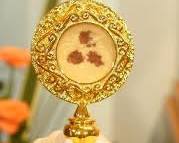Recently the parish I attend in Pennsylvania, St. Michael’s in Canton, Pa, hosted a Eucharistic Miracles display in the social hall (thanks to David for making this happen). This display featured 80 panels highlighting the numerous miracles associated with the eucharist around the world over the centuries. There were incidents where the consecrated hosts exuded red substance later confirmed to be human blood and having the same blood type as the blood found on the Shroud of Turin. There were also examples of the host turning to flesh, later revealed to be actual heart muscle. There was a case of thieves stealing a monstrance, with the Blessed Sacrament in its holder, then abandoning it it a remote location. Later its location was revealed by a bright beam of light seen for miles around.
And before you say these things only occurred centuries ago, you should know that the latest approved eucharistic miracle occurred on December 25th in 2013 at the Church of St Hyacinth in Legnica, Poland. A consecrated host fell to the floor and was then placed in water to dissolve , as is the accepted procedure. When investigated the next day, not only had the host not dissolved but formed red stains. Later it was confirmed that the red stains were remnants of heart muscle.
In todays first reading from the Acts of the Apostles we see Peter at work healing the sick and raising from the dead. He heals a paralyzed man in the town of Lydda and then he is called to Joppa where a beloved and charitable woman named Tabitha (no, not the little witch from the TV show Bewitched) had fallen ill and died. Peter raised Tabitha from the dead by commanding her to arise.

from “Bewitched”
And in the Gospel we continue with the Bread of Life discourse from John, Chapter 6. In it, Jesus tells His disciples, those who had been closest to Him during His ministry, that they must “eat my flesh and drink my blood to have life”. The vast majority leave Jesus because this teaching is “too hard”. They believed that Jesus was telling them to become cannibals and they could not accept this from the person who they believed was destined to lead them from slavery under the Romans. Jesus then turns to his apostles, the 12, and asks them if they are going to leave as well. Peter responds that there is no where else to go. Not like Jesus is all that remains but because He is the only one to have the true words of everlasting life. Nothing else compares to that. And while they do not understand the miracle that will be the changing of bread and wine to His body and blood at the Last Supper, they have faith in Jesus…true man and true God. So what he says may sound impossible, but they trust and believe.
We know that it was not Peter who healed the paralytic or raised Tabitha from the dead. It was God. Or rather it was Peter’s relationship with God…with Jesus…that led to these miracles. It was God who did that!! Not Peter. Just as it was God who healed the lame man outside the temple, but did it through Peter and John.
I am sure that there are plenty of skeptics who hear about Eucharistic Miracles and dismiss them and some trick or hoax perpetuated over the centuries. And there are others whose faith is rekindled or strengthened by these, and other, miracles. The numerous Marian apparitions. The miracle of the sun at Fatima. Jesus appearing to St. Faustina.
How do we react when we hear of these miracles? Do we dismiss them out of hand or do we have faith enough to wait and see how they play out as they are investigated by the Church? And when they are recognized as valid, do we then accept or reject? Jesus Himself did not perform His many miracles as a show of power. Nor did he cure and heal people solely for their benefit. After all, even those who were raised from the dead, eventually died. Jesus had a higher purpose. Miracles themselves are a sort of sign or guidepost directing people to God. They awaken a sense of wonder to those whose hearts are open. In the town of Lydda, the population was made up primarily of Christians. And after Peter performed the healing of the paralytic we read that “And all the inhabitants of Lydda and Sharon saw him, and they turned to the Lord. “

But in Joppa, the majority of the citizens were Jewish. Not yet believers. And after Tabitha was actually RAISED FROM THE DEAD, we read that “This became known all over Joppa, and many came to believe in the Lord.” MANY…not ALL, as was the case in Lydda. Why was it that raising a person from the dead did not convert ALL to belief in Jesus? To healing in His name. I think the answer to that question was answered by St. Thomas Aquinas in his famous observation:
“For those with faith, no evidence is necessary; for those without it, no evidence will suffice.”
